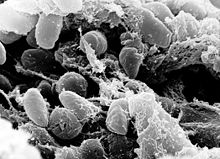Sylvatic plague
| Sylvatic plague | |
|---|---|
 |
|
| A scanning electron microscope micrograph depicting a mass of Yersinia pestis bacteria in the foregut of an infected flea. | |
| Scientific classification | |
| Domain: | Bacteria |
| Kingdom: | Eubacteria |
| Phylum: | Proteobacteria |
| Class: | Gammaproteobacteria |
| Genus: | Yersinia |
| Species: | Y. pestis |
| Binomial name | |
|
Yersinia pestis (Lehmann & Neumann, 1896) van Loghem 1944 |
|
Sylvatic plague is an infectious bacterial disease caused by the bacterium Yersinia pestis that primarily affects rodents such as prairie dogs. It is the same bacterium that causes bubonic and pneumonic plague in humans. Sylvatic, or sylvan, means 'occurring in wildlife,' and refers specifically to the form of plague in rural wildlife. Urban plague refers to the form in urban wildlife.
It is primarily transmitted among wildlife through flea bites and contact with infected tissue or fluids. Sylvatic plague is most commonly found in prairie dog colonies and some mustelids like the black-footed ferret.
Sylvatic plague is most commonly found in prairie dog colonies; the flea that feeds on prairie dogs (and other mammals) serves as the vector for transmission to the new host.
Sylvatic plague is primarily transmitted among wildlife through flea bites and contact with contaminated fluids or tissue, through predation or scavenging. Humans can contract plague from wildlife through flea bites and handling animal carcasses.
Yersinia pestis circulates in rodent and prairie dog reservoirs on all continents except Australia. Sylvatic plague affects over 50 species of rodents worldwide. It is vectored by a variety of flea species. Non-rodent animals susceptible to the disease include shrews, Lagomorphs, ferrets, badgers, skunks, weasels, coyotes, domestic dogs and cats, bobcats, mountain lions, camels, goats, sheep, pigs, deer, nonhuman primates and humans. Birds are not known to be susceptible.
...
Wikipedia
